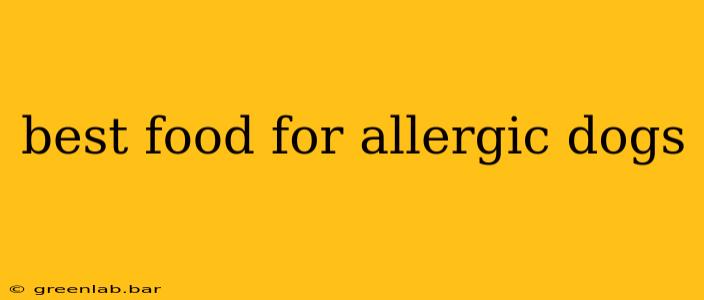Dealing with a dog allergy can be incredibly frustrating for both pet and owner. Itchy skin, digestive upset, and even more serious reactions can significantly impact your dog's quality of life. Finding the right food is crucial in managing these allergies and ensuring your furry friend thrives. This comprehensive guide explores the best foods for allergic dogs, covering different types of allergies, ingredients to avoid, and how to choose the right diet for your specific canine companion.
Understanding Dog Allergies
Before diving into specific food recommendations, it's essential to understand the different types of allergies your dog might be experiencing. Common canine allergies include:
Food Allergies:
These are triggered by specific ingredients in your dog's food. Common culprits include:
- Proteins: Beef, chicken, dairy, soy, wheat, and fish are frequent offenders. The protein source is often the primary trigger of food allergies.
- Grains: Corn, wheat, soy, and rice can also cause allergic reactions in some dogs. Grain-free diets are often recommended for dogs with suspected food allergies.
Environmental Allergies:
These are less directly related to diet but can manifest similarly. Environmental allergies are triggered by things in the environment, such as pollen, dust mites, and fleas. While diet won't cure environmental allergies, managing them often involves supporting skin health through a good diet.
Identifying the Allergen:
Pinpointing the exact allergen is key to effective treatment. This often requires working closely with your veterinarian. They may recommend an elimination diet, where you gradually introduce new food ingredients to identify potential allergens. Blood tests and skin prick tests can also be used to determine specific sensitivities.
Best Food Choices for Allergic Dogs
Once you've identified the allergen (or allergens), you can choose the most appropriate food for your dog's needs. Here are some key considerations:
Hydrolyzed Protein Diets:
These diets contain proteins that have been broken down into smaller peptides, making them less likely to trigger an allergic reaction. These smaller proteins are essentially unrecognizable to the dog's immune system. This is often a first-line approach for managing severe food allergies.
Novel Protein Diets:
These diets utilize protein sources that are uncommon in commercial dog food. Examples include venison, kangaroo, duck, or rabbit. The idea is to introduce a protein your dog hasn't previously encountered, reducing the likelihood of a reaction.
Limited Ingredient Diets:
These diets contain a small number of easily identifiable ingredients, minimizing the risk of exposure to potential allergens. They typically feature a single protein source and a single carbohydrate source. This allows for easier identification of the culprit if an allergic reaction occurs.
Grain-Free Diets:
While not always necessary for all dogs with allergies, grain-free diets can be beneficial for dogs sensitive to common grains like corn, wheat, and soy. However, remember that simply avoiding grains isn't a guaranteed solution, and other ingredients can trigger allergies.
Ingredients to Avoid
Regardless of the specific type of allergy, some ingredients should generally be avoided in dogs with allergies:
- Artificial colors and flavors: These can irritate the digestive tract and worsen skin conditions.
- Fillers: Corn syrup, soy, and other low-nutrient fillers add bulk but little nutritional value, potentially triggering allergic reactions.
- By-products: These are often poorly defined and can contain allergens.
Choosing the Right Food: A Step-by-Step Approach
-
Consult your veterinarian: This is the most crucial step. Your vet can help diagnose the allergy, recommend specific food options, and monitor your dog's progress.
-
Read labels carefully: Look for clear and concise ingredient lists. Avoid foods with vague terms or long lists of artificial ingredients.
-
Start with a small amount: When introducing a new food, begin with a small quantity and gradually increase the portion size over several days. This allows you to monitor for any adverse reactions.
-
Be patient: It may take time to find the perfect food for your dog. Don't get discouraged if the first option doesn't work.
-
Monitor your dog's symptoms: Keep a close eye on your dog's skin, digestion, and overall behavior. Note any changes after introducing a new food.
Conclusion
Finding the best food for an allergic dog requires careful consideration, veterinary guidance, and patience. By understanding the types of allergies, choosing the right food type, and avoiding potentially problematic ingredients, you can significantly improve your dog's comfort and health. Remember, consistent monitoring and open communication with your veterinarian are key to long-term success in managing your dog's allergies.

